Can your dog make an entire bowl of food disappear faster than you can say, “Bon appétit?” Has he ever inhaled a bowl of food so fast he vomited it back up a few minutes later? Does her seemingly frantic consumption lead to gagging or choking?
If any of these scenarios sound familiar, it’s wise to check out one of many commercially available slow feeders or experiment with creating one yourself to help your dog dial down her speed-eating ways.
Eating too fast can lead to gagging and choking – plus, speed eaters tend to gulp air as they execute their deep-dive into the food bowl. This excess air can interfere with digestion, cause gas, and even lead to gastric dilation and volvulus, commonly known as “bloat,” a potentially fatal condition where the stomach fills with excess gas and flips on itself, restricting blood flow and requiring life-saving emergency surgery.
Slow-feed bowls and other tools also can help turn mealtime into an opportunity for enrichment. When using a slow feeder, your dog can tap into his problem-solving abilities as he maneuvers the device. This engages his brain more than when simply diving face first into an open bowl of food. Mental exercise is just as important as physical exercise in creating a well-rounded canine companion.
The ability to slow a dog’s eating is also critically important to the success of certain training protocols. For example, when working with a dog who tends to guard his food, it’s helpful if he’s eating slowly enough to give us time to implement some behavioral interventions.
A common positive-reinforcement approach to working with a dog who guards his food is to pass by the dog as he eats and drop a food item considered “better” than what’s in his bowl; this helps to counter-condition how the dog feels about a human approaching his food. However, if the dog inhales the contents of the bowl before you can approach, this is difficult to accomplish!
While slow-feel bowls are helpful, another approach to slowing a speed-eater is to ditch the bowl all together in favor of stuffed food puzzles, planned scavenging opportunities, or even hand-feeding via training. There’s no rule that says dogs must eat meals at set times, and from a bowl! Often, high-energy dogs benefit from a “sit quietly and color” activity such as extracting part of a meal from a well-stuffed, frozen Kong or a Toppl toy, and it’s easy to split a dog’s daily ration of kibble into three or more puzzle toys to be offered at different times throughout the day.
Snuffle mats allow dogs to fully engage their sense of smell as they poke around the fabric strips in search of kibbles. You can even offer a wide-spread kibble scatter out in the yard as if you’re feeding chickens! (Admittedly, these last two techniques work better with kibble than with home-prepared or raw diets, but these work well in Kongs and Toppls.)
And of course, there’s training time! On busy training days, my dogs have always eaten very little from a bowl. Rather, I’m leveraging their daily caloric intake in an effort to generously reinforce desired behaviors – especially when working with them as young puppies.
Don’t be afraid to ditch the dog bowl in favor of more creating feeding strategies that support your training goals and the development of a harmonious household!
SPEED TESTS
We selected five commercially available products that are marketed as able to slow a fast eater. We timed how long it took our test dog, Saber, an 8-year-old Golden Retriever, to navigate each bowl. Each timed trial was compared to his baseline of 2:00 to eat a meal consisting of two cups of kibble with a small amount of water (to dissolve a powdered supplement) from a regular stainless steel dog bowl.
We recognize our test dog’s standard approach to a bowl of food doesn’t necessarily qualify as “speed eating” – many of you may have even faster chow hounds – but he’s in no way a “picky eater.” He dives into the bowl, eats with enthusiasm, and doesn’t leave the bowl until the food is gone.
Beyond timing how long it took to empty each bowl, we also considered cost, materials, ease of use, and how easy each product is to clean. Hungry to know more? Here’s what we discovered, listed in order of least to most additional time needed to finish a meal.
DOG HOG

The Dog Hog is a weighted stainless steel ball, reminiscent of those gazing balls popular in backyard gardens in the early 1990s. It comes in two sizes: The small Dog Hog measures 2.88 inches in diameter and weighs six ounces and the large measures 3.5 inches and weighs 8 ounces.
The Dog Hog is super easy to use. Simply place it in your dog’s bowl and add food around it. The smooth, slippery nature of the Dog Hog makes it difficult for a dog to be able to successfully lift it out of the bowl in order to better reach and gobble the food. Its weight makes it challenging to shove it out of the way. It’s certainly not so heavy that it can’t be moved, but in our test, it wasn’t easily chased around in the bowl by an enthusiastic snout.
It should be noted that sound-sensitive dogs may not appreciate the sound of the stainless steel ball rolling around in a stainless steel dog bowl.
Its simple design gives Dog Hog high marks for ease of use both in the bowl and when it’s time to clean the device. However, it added only 1:02 minutes to the time it took Saber to finish a meal, bringing his total eating time to 3:02.
WOBBLER SLOW FEEDER

As I unpacked the Wobbler, I was reminded of the classic 1970s childhood toy and its jingle, “Weebles wobble but they don’t fall down!” This fishbowl-shaped slow feeder functions in much the same way; it can be pushed over in all directions, but thanks to its weighted silicone base, it rights itself as soon as it’s released. You pour your dog’s food inside the fishbowl, er, bowl, and your dog has to put his head inside it to chase the food around the inside of the bowl.
The Wobbler stands about 5.5 inches tall, is about 4 inches deep, and has a 5-inch opening. The top 2 inches can be unscrewed and removed, reducing the Wobbler’s overall height to 3.5 inches, but more importantly, reducing the depth to just 2 inches and increasing the diameter to 6.5 inches. This is great for smaller dogs – or any dog who might be leery about lowering his head into a relatively small space.
The bottom half of the Wobbler sphere has an interior bowl with a series of ridges inside, creating channels around which the kibble falls. This interior bowl spins within the external sphere, but when we spun it by hand, we felt a fair amount of friction, so we’re not quite sure how much, if any, spinning happens as the dog eats.
When it came time to clean the bowl, we couldn’t figure out how to remove the internal bowl, and were ready to just chuck the product altogether. Cooler heads prevailed, however, and WDJ’s editor pointed us toward a video on the Wobbler’s Amazon page that showed how it can be done. Okay! It was back in the test.
According to the manufacturer, the Wobbler holds up to four cups of food, is made with food-safe plastics, and is BPA-free. We appreciate its unique ability to adapt to both large and small dogs.
The Wobbler added 1:50 to the time it took Saber to finish a meal, bringing his total eating time to 3:50.
GOBBLESTOPPER
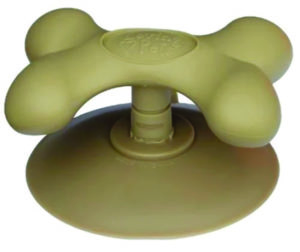
When we selected products to review, “ease of use” was one of the attributes we looked for, and the Gobblestopper looked very easy to use, so we gave it a try.
The Gobblestopper consists of a molded plastic bone on a one-inch base that suctions onto the bottom of any flat-bottomed dog bowl. The dog has to eat around the obstruction and use his tongue to sweep the food out from under the bone.
We used the Gobblestopper in a stainless steel bowl with an interior diameter of 7 inches, which left about 1 to 2 inches of space between the device and the walls of the bowl. It took Saber an extra 2:51 minutes to finish a meal, bringing his total eating time to 4:51.
We did run into an issue with the suction cup not sticking well to the bottom of the bowl, and near the end of the meal, we noticed it was being pushed around as Saber worked to extract the final kibbles. The suction cup itself is extremely shallow, which likely makes it difficult to achieve a strong seal. Adding water to Saber’s food may have also lessened the strength of the seal.
Had the suction cup done a better job, we’d give the Gobble Stopper higher marks, as it’s easy to use, easy to clean, and more than doubled the amount of time it took our test dog to eat a meal. Unfortunately, given that it sometimes fails to stick to the bowl for the duration of the meal, we’re less enthusiastic about recommending it.
BRAKE-FAST BOWL

Many people prefer stainless steel bowls for their non-porous quality, so we were happy to add a stainless steel slow feeder to our roster. The stainless Brake-Fast Bowl is essentially a standard dog bowl with three removable posts around which food is added. This bowl is available in small (1 quart), medium (2 quart) and large (3 quart) sizes. We tested the 2-quart bowl.
With more than 2 inches between the posts themselves, admittedly, we weren’t expecting much in terms of challenge, so we were surprised to discover it added nearly 3:00 to our test dog’s eating time, increasing the total eating time to 4:52!
Interestingly, we noticed Saber tended to pick up and chew bites of food more often using this bowl compared to other bowls, and kibbles positioned between a post and the side of the bowl seemed especially challenging to extract. The Brake-Fast bowl has a non-skid edge, but it did slide a little as Saber worked to get the final few pieces of food.
While we loved the unexpected challenge this bowl provided for Saber, we were less than thrilled to discover that the product comes with five-part cleaning instructions.
Per the manufacturer, to properly clean the bowl, one must first unscrew the posts, hand wash all parts with warm soapy water (while taking care to not submerge the posts), dry thoroughly, and then reattach the posts without over-tightening. That’s a lot of steps!
The company also makes a plastic Brake-Fast bowl with molded permanent stanchions, and, as much as I like stainless steel, I think I’d prefer the simplicity of hand-washing the plastic version that doesn’t have to be taken apart and put back together for cleaning.
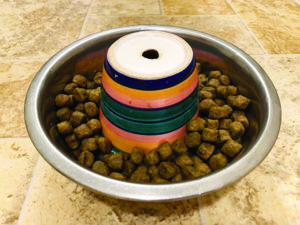
Chances are, you already have items around the house that can be repurposed to create a slow-feed bowl for your dog. Try experimenting with one of these DIY alternatives to a commercial slow-feed bowl:
* Add a small, upside down terracotta pot to your dog’s dish. The pot placement creates a “moat” from within which the dog works to extract the kibble. Similarly, you can add a large rock to the center of the bowl. (To protect his teeth, make sure the dog doesn’t try to pick up the rock.)
* Turn a muffin tin into a meal puzzle. Add varying amounts of kibble to each of the individual muffin cups. Top cups with dog-approved items to be removed first, such as a tennis ball or Kong toy.
FUN FEEDER SLO-BOWL
Our winner in the slowing-down-the-dog contest? The Fun Feeder Slo-Bowl, which added a whopping 8:15 to the time it took Saber to finish a meal, for a total eating time of 10:15!

The Fun Feeder comes in three sizes, five colors, and four challenging designs. We tested the Large/Regular “Purple Flower” Fun Feeder, which is 11.75 inches in diameter, two inches deep and holds up to four cups of food. The mini Fun Feeder of the same design is 8.5 inches in diameter, 1.75 inches deep and holds up to two cups of food.
This entire feeder is a complex challenge; there’s not a single area of the bowl that appears to create the opportunity for an easy-grab bite. The widest part throughout the interior of the design is only about 1 inch, making it nearly impossible to reach in and “bite” a mouthful of food. Rather, it seems food must be scooped into the mouth using the tongue as a spoon. If you need to really slow down a dog, this seems like a good option.
My dog would probably be happy to know that the bowl created challenges for me, too. I add a powdered supplement to Saber’s food, and mix it into his food with a little water, but because this slow-feeder doesn’t have any bowl-like area in which to mix the supplement into the food, I had to use a separate bowl for mixing, and then dump it into the Fun Feeder, scraping as much of the (expensive!) supplement off the sides of the first bowl. Kind of a pain.
Also, the narrow channels made it difficult to hand-wash, but per the manufacturer, it’s top-rack dishwasher safe. It’s also free of PBA, PVC, lead, and phthalates.
VARIETY, SPICE OF LIFE
I’ve always been a fan of food puzzles for dogs, especially young puppies. All of my dogs have consistently eaten at least some of their daily ration of food out of frozen stuffed Kongs or Toppl toys, or from a snuffle mat of some sort. 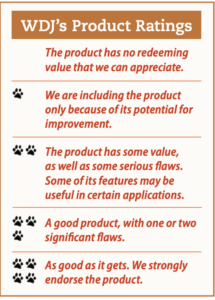
While I’m not worried about the general speed with which Saber eats his meals, I’ve still chosen to keep the Dog Hog, Wobbler and Fun Feeder in weekly rotation to add a little extra variety, and hopefully, mental stimulation to what can be an otherwise very predictable dining experience.
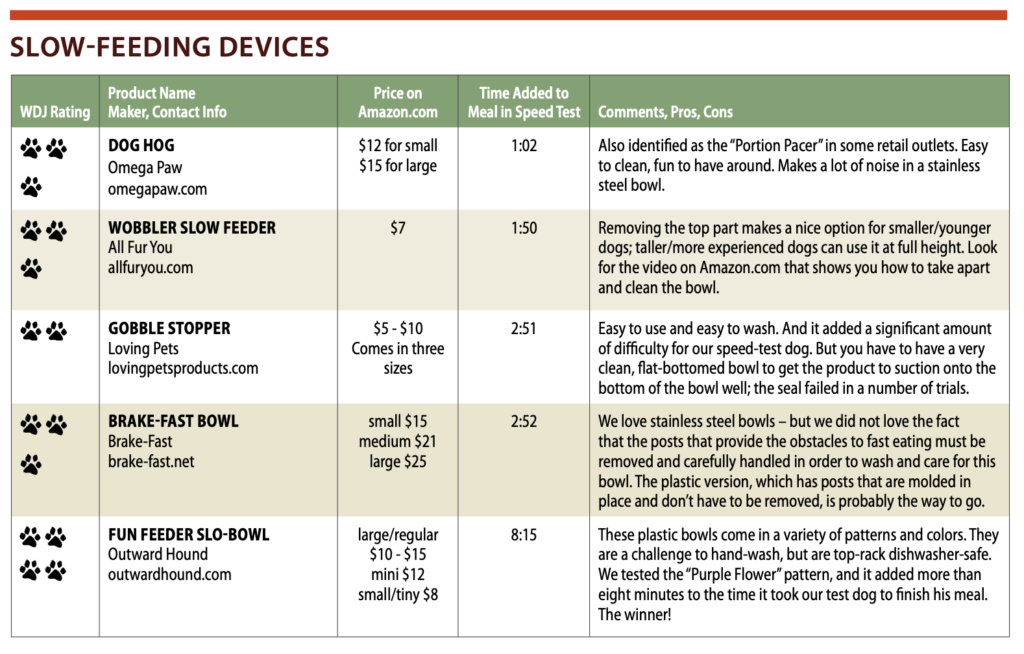


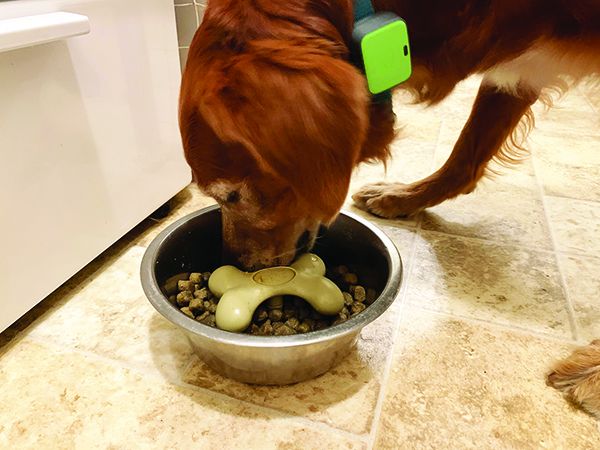
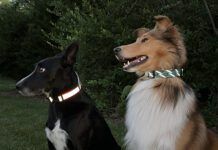


Thanks for reviewing all the types of bowls. Now tell me how to stop the dog from just picking up the bowl and dumping all the food out!
Hahaha My adult dogs never did that, but a puppy figured it out fast!
I have a Golden Retriever and the orange spiral Fun Feeder. It slows him down a little. I haven’t timed, but maybe I will. It certainly doesn’t take him 10 minutes to eat his one cup of food. He also gets a powdered supplement but I just put that in a separate bowl.
One of my favorite interactive food toys is the Orbee Tuff. I’ve found that all of my dogs enjoyed tossing that around to get the food to fall out.
One thing I tried today was to scatter his food around two rooms. I didn’t time that either, but he seemed to enjoy looking for his food.
We take a small, heavy, stoneware cup (an old Hall’s egg cup) and turn it upside down in his dish. It moves around as he tries to reach every last bit of food and makes a lot of noise but it slows him down a lot. (and the puzzle is always changing so he doesn’t develop a strategy for gaming it.)
My dogs could eat a meal in about two seconds, so I put a big rock in their bowls that they couldn’t pick up and get rid of. They had to eat around it. Later I thought it might be hard on their teeth so I switched to a Kong that worked just as well. Though they could pick it up and get it out of the way if they wanted, they don’t.
I’ve been using the purple flower fun feeder for a couple of years now with my collie mix. I also add a powdered supplement and some broth powder. I mix it in a separate bowl with warm water and then he licks that bowl before he gets the food I put in the feeder- so there’s no waste!
I have a corgi, he used to eat his food in about 10 seconds. Sometimes he throws up, and he become fat. Then I bought him this large slow feeder bowls from a brand named PETDURO on amazon. The bowl slows down his eating effectively. Now he can eat with that bowl in 5-7 minutes. I’m very grateful for the bowl. I drop the link here just in case you or anyone who needs it: https://www.amazon.com/PETDURO-Capacity-Non-Slip-Cleaning-Indigestion/dp/B07LDQNL5Z
What is the green device on the neck of of the Golden Retriever in the first photo ((your test dog). Great info on slow feeders.
Hi. I was wondering what that was also. My guess, a reciever for an electronic fencing system or excessive barking deturant device.
My dog is em old dog he’s take he’s time to eat all the time…
It’s a Whistle Go Explore activity and GPS tracker — it’s reviewed in the current issue!
I will have to try one of these as my dog scarfs his food down in no time. Mabey one of them will slow him down. Thanks for the article.
I have used the Gobblestopper a couple of times. It has worked well for me, even when it did not stick to the bottom. Unfortunately, the last one was destroyed by one of my other dogs who found the base a wonderful chew toy! She absolutely destroyed it! So I decided to try the Brake-Fast bowl because of the stainless steel construction. I’m afraid the other dogs would eat the other plastic bowls like they ate the Gobblestopper. But I may try them anyway, and just try to pick them up after my boy, Hunter (the gobbler) finishes up.
Thanks for the review. It has been very helpful!